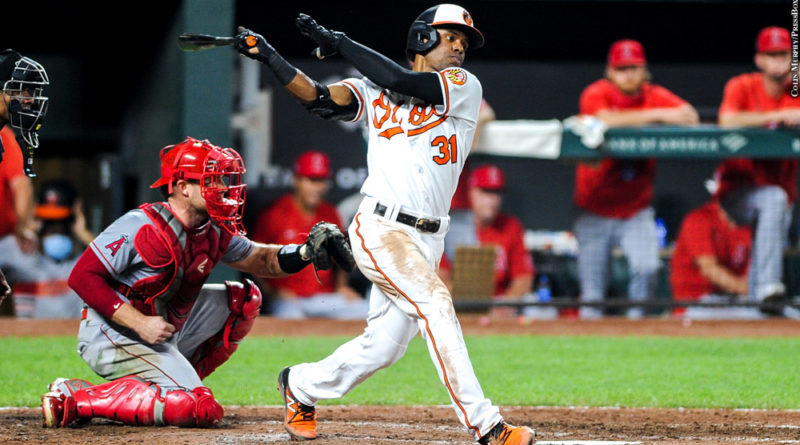With his team 55 games under .500 and nearing the end of another lost season, Cedric Mullins received a loud ovation while he rounded the bases in a late September game against the Texas Rangers, then during a curtain call once he returned to the dugout. When he jogged out to center field the next inning, he did so alone to give fans a chance to shower him with even more praise. The latter was coach Fredi González’s idea.
It was well deserved. That night, the 5-foot-8 center fielder stood tall, becoming the first player in Orioles history to hit 30 home runs and swipe 30 bases in the same season. None of the legends who donned the orange and black in Baltimore throughout the years ever accomplished what Mullins did.
Simply sticking with the O’s for the entire season would have been an impressive feat for Mullins. His story is well known by now, but it’s worthy of a quick recap. The intriguing, speedy prospect was promoted in August 2018 and took over center field duties from fan favorite Adam Jones. He began 2019 as the Orioles’ Opening Day center fielder … then was demoted to Triple-A Norfolk in the season’s first full month after posting a .094/.181/.156 batting line in 74 plate appearances.
Things got worse before getting better. Mullins failed to impress during his stint in Norfolk, and he was demoted again, to Double-A a few months later. But he finally started to turn things around, and after a short stint at the alternate training site in Bowie during the pandemic-shortened 2020 season, he was back in the Orioles’ plans. As widely reported, his retooled swing and a better mindset were driving forces in his resurgence.
None of that prepared anyone for what Mullins was about to do. Before the 2021 season, he announced that he was abandoning switch-hitting to bat exclusively from the left side. What seemed like a reasonable idea could hardly have gone much better. In 159 games and 675 plate appearances, Mullins batted .291/.360/.518. His 136 wRC+ ranked 21st among all qualified hitters. His 5.3 WAR (FanGraphs’ version) tied for 12th best.
Unsurprisingly, Mullins was among the very best compared to other major-league center fielders. Only Bryan Reynolds and Starling Marte (5.7) posted higher fWAR totals. Only Reynolds (142) had a better wRC+. Only rookie Adolis García (31) hit more home runs. Only Marte (47) had more steals. Mullins also ranked fourth among all center fielders (+11) in Statcast’s Outs Above Average metric. He certainly wasn’t lacking when it came to defensive highlights.
Oh yeah, and back to that whole 30-30 achievement. Mullins’ feat was the first for a major-league center fielder since Mike Trout did it in 2012. Pretty solid company.
Mullins didn’t just hang with some of the very best players in 2021, though. He posted one of the very best seasons for an Orioles center fielder. His 5.3 fWAR places seventh all time behind names like Paul Blair (three times), Brady Anderson (yup, the 50-homer year), Al Bumbry and Merv Rettenmund. Adam Jones and Mike Devereaux, as talented as they were, never had 5-fWAR seasons.
Factoring in all position players in O’s history, Mullins’ 5.3 fWAR is just shy of the top 50 (a handful are tied at 47th, with 5.4). But let’s narrow the scope a bit. Looking at the last decade, only three players had better seasons by fWAR than the one Mullins just put up. Chris Davis and Manny Machado each did it twice, and Matt Wieters did it once. Once again: strong company.
What’s interesting is that Mullins’ numbers would have looked even better if he hadn’t limped to the finish line. After collecting his 30th home run, he had only two hits in 27 plate appearances in his last eight games. Maybe a sore hamstring bothered him more than it was reported. Maybe he wore down after a demanding season. Or maybe he just went on a cold spell when the season ran out.
Regardless, no one can take away what Mullins just did. They can, though, ask what’s next. In 2021, he shattered every expectation of his abilities and carved out a new trajectory for his career. Will this be one of those one-off seasons that fans marvel at down the road, unsure of how they happened? Or will this be the version of Mullins fans can expect moving forward?
The former is the potential result that Mullins has to ward off. The latter is a tall task for nearly any player, let alone one who reemerged onto the scene like he did in 2021. Because Mullins’ defense and speed figure to be factors for years to come, the difference in Mullins being decent and an All-Star boils down to what he does at the plate. Whether he keeps barreling the ball, walking more, striking out less and holding his own against left-handed pitchers will all play a significant part.
No one can say they thought this discussion surrounding Cedric Mullins would ever take place. It’s a welcome surprise for an organization that could use many more of them.
Weighted runs created plus (wRC+) is an offensive metric in which 100 is the league average and every point above 100 is a percentage point above league average.

